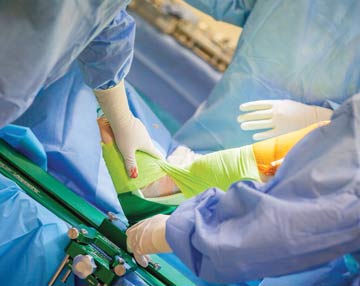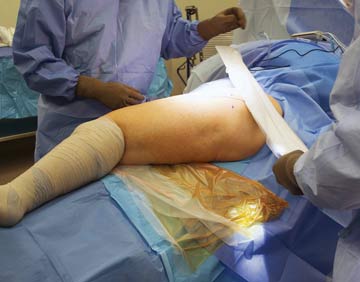April 25, 2024
Growing demand for anesthesia services at ASCs is being met with a dwindling supply of anesthesia providers....
This website uses cookies. to enhance your browsing experience, serve personalized ads or content, and analyze our traffic. By clicking “Accept & Close”, you consent to our use of cookies. Read our Privacy Policy to learn more.
By: Kendal Gapinski
Published: 7/14/2020
The proper positioning of patients undergoing orthopedic procedures prevents nerve and skin injuries and gives surgeons better access to the joints they're repairing or replacing. Spending a few extra minutes before cases begin to make sure knees are flexed, hips are hyperextended and shoulders are secured pays off in successful outcomes and safer patient care. Charlene DiNobile, RN, M.Ed, CNOR, CST, NEA-BC, CSPDT, CFER, a professor at the New England Institute of Technology, says you should focus on these pillars of proper positioning:
Don't rely on egg crate foam surfaces and traditional pillows, as they do not distribute pressure effectively and tend to compress quickly under the weight of the patient's body. If you are using these types of materials, however, it's best to support low weight-bearing areas, such as under the knees.
Finally, confirm that needed positioning aids are on hand and ensure staff have the working knowledge, through in-servicing, of how to use each device safely and effectively.
It's also crucial to assess the patient's risk for a positioning complication. "Gain as much information as you can about their range of motion status in pre-op," says Jenni Prevatt, MS, RN, CNOR, quality improvement nurse analyst and surgical nurse reviewer at UC Davis Children's Hospital in Sacramento, Calif. "Explain to the patient how they will be positioned during surgery. That way, they'll be more likely to speak up if they foresee a positioning issue based on their known range of motion limitations."

Knee replacement patients are typically placed in the supine position, with arms on armboards and the operative knee propped or flexed. Be sure these areas are padded and protected when patients are in supine position:
For other procedures, such as arthroscopic anterior cruciate ligament reconstruction, the non-operative leg may be positioned in a stirrup in low lithotomy. This can prove risky.
"Carefully place the leg in the stirrup and make sure it's secured," says Ms. Prevatt. "In low lithotomy, the hips should be flexed no more than 60 degrees from the table's surface. Too much flexion or abduction can injure the sciatic nerve."

Hip arthroplasty is performed with a posterior approach, direct lateral approach or direct anterior approach. The anterior approach requires placing the patient in the supine position with the leg on the side of the operative hip hyperextended to just off the floor. Operating at the front of the hip is a muscle-sparing technique that results in shorter recoveries, but is technically demanding for surgeons to perform. The lateral approach can be performed with the patient in the lateral decubitus position or supine position. The posterior approach is performed with the patient in the lateral decubitus position. Ms. Prevatt suggests protecting the following areas when placing patients laterally:
Surgeon preference determines how patients are positioned for shoulder surgery; some prefer the lateral decubitus position and others utilize beach chair positioning. Each option has associated benefits and drawbacks. The lateral decubitus position improves visualization of and access to lateral pathology during stabilizing procedures. However, the position involves placing patients in a non-anatomic position and can increase the risk of thromboembolic complications. The beach chair is a more anatomic position that reportedly results in fewer neurovascular complications and provides increased visualization of the entire joint. It can lead to higher rate of hypotensive and bradycardic events, and limits access to the posterior areas of the joint. Ms. Prevatt says there are several high-risk areas to protect on patients placed in the beach chair position:
When positioning patients laterally with a bean bag positioner, make sure the device is clean, in good working order and free from leaks, suggests Ms. DiNobile. She recommends having a designated team member check for excessive pressure on male genitals and female breasts at regular intervals during surgery. Additionally, says Ms. DiNobile, make sure a staff member is assigned to hold the patient's head while securing the positioning aid.
Recheck patients' skin in recovery, looking for redness or signs of neurological injuries, and educate patients on how to self-assess for pressure-related complications when they return home, says Ms. Prevatt.
Improving your patient positioning protocols should start outside of the OR, with your facility developing and implementing guidelines with input from your surgical team and PACU nurses, says Ms. DiNobile. "Don't wait for a poor outcome," she adds. "For the continuing safety of your patients, all surgical team members must be instructed on patient positioning risks and follow best practice on every patient, every day." OSM
Growing demand for anesthesia services at ASCs is being met with a dwindling supply of anesthesia providers....
Improvements in both workflow and staff attitudes are part of a leader’s responsibilities, but your interventions in these areas don’t need to be major to make...
The ASC market continues its rapid growth. In 2023, roughly 116 new ASCs opened in the U.S., many of which were orthopedic-specific in nature....